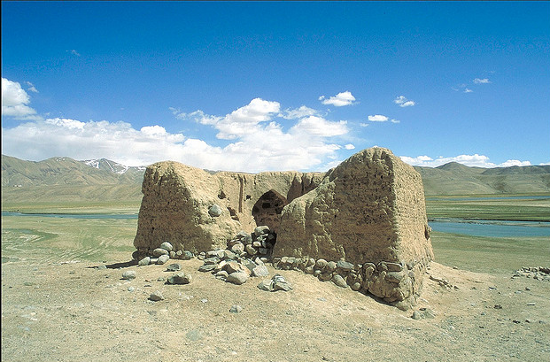2000 years ago, one of the main arteries of the Silk Road ran through the Pamirs. A network of fortresses was built along the way to protect trade and demand taxes by the Kushan empire, famous for their Greco-Buddhist art (yes, Tajikistan was buddhist).
The Pamir fortresses are a memory of a more lively time on the Roof of the World. Their unworldly desolation suggests a more hospitable climate in the past, when communities thrived around them.
Although one fortress is still being used to guard the border, the others have lost their purpose, and their walls. Just a bit of rubble is left, to remind us of the fleeting nature of great empires.

Via fyeahtajikistan
Built in the 3rd century BC, Yamchun fortress is locally referred to as Zamr-I Atisht Parasht, the fortress of the fire worshippers, meaning Zoroastrianism was strong in the Pamirs back then. A fire temple might have housed inside the fortress.
A view from close up.

via Panoramio
Khakha (Kaakha, Khakhka) is another well-kept fortress. Its location overlooking the Afghan border means it is still in use by Tajik border guards today, so watch out, some people have reported being harassed (some people haven’t).

via Tim Motz@Flickr
Stairs leading up to Kakha fortress.
The fortresses are a great excuse to hike and explore, even if there is little to see. This is a fortress near the village of Savnob.

via Panoramio
Savnob, nestled deep in the spectacular Bartang valley.

Via Trui Gaea @Flickr
Near Roshtqala, the castle of Deruj.
Ratm fortress (no connection with Rage against the Machine – yet).

via Panoramio
The mausoleum of Bekbulat near the stunning Green Lake, Yashil Kul. There are hot springs here, and 4000-year old Zoroastrian remains near the mouth of the Bolshoi Marjonai river.
Yashil Kul.

Via Panoramio
The castle at Shashbuvad.
The remains of Abrashim Qala, framed by the slopes of the Wakhan Valley.





